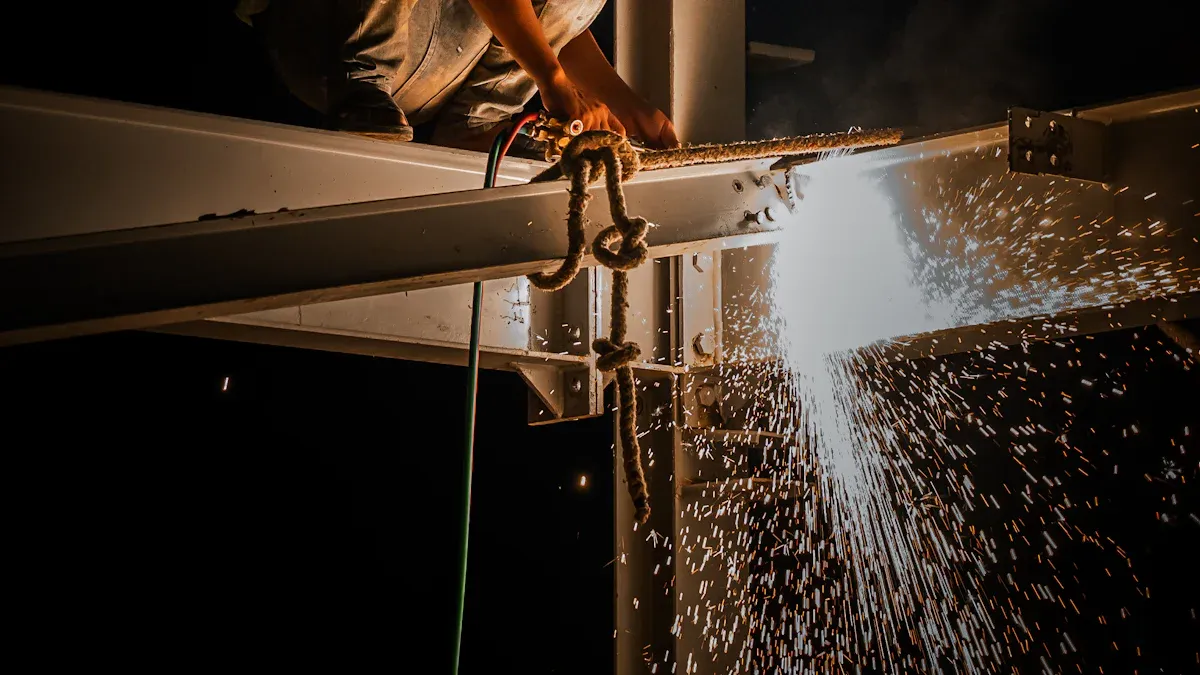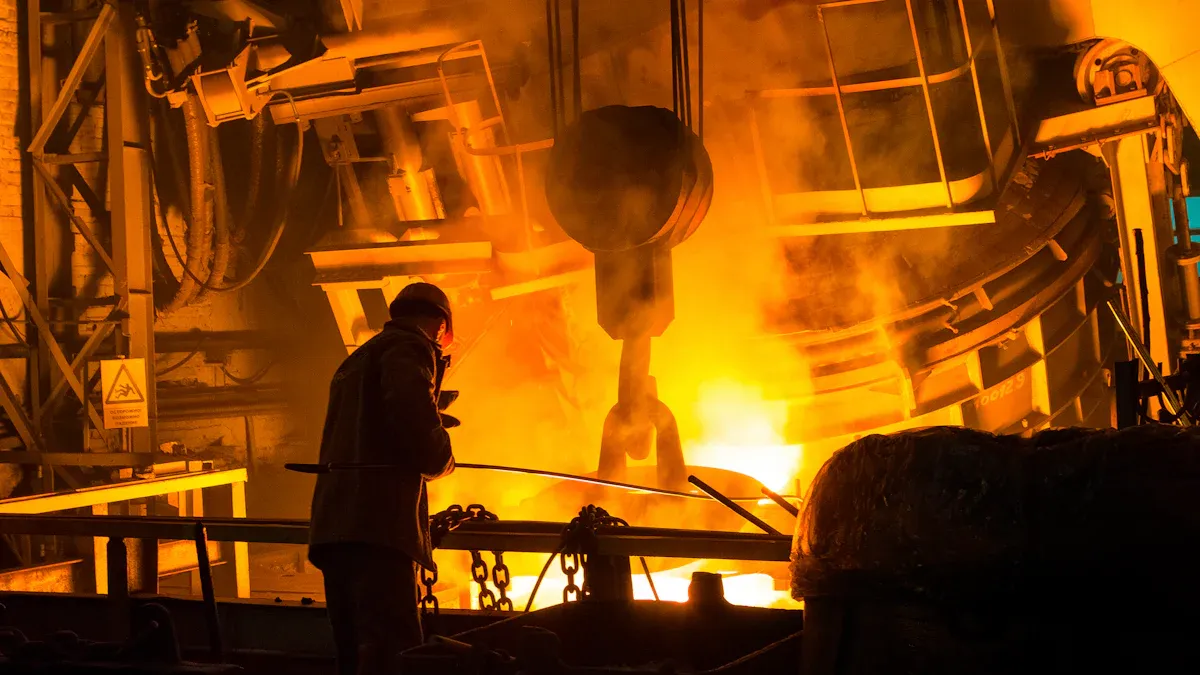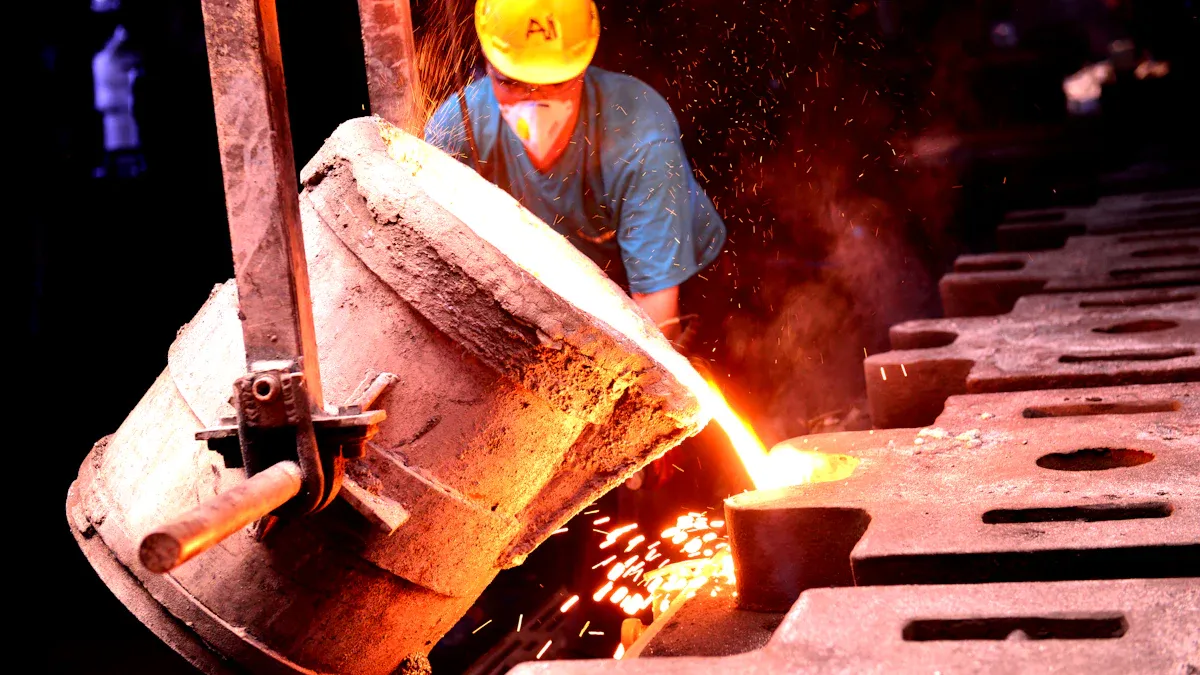
Safety plays a vital role in the investment castings process. Workers face numerous risks daily, including burns from molten metals, exposure to harmful chemicals, and injuries from heavy machinery. Without proper investment casting, employee precautions, these hazards can lead to severe accidents. For instance, defective equipment once caused molten metal to splash, resulting in severe burns and even fatalities. Adhering to safety protocols ensures not only worker well-being but also smooth operations in investment precision ..
Understanding the Risks in Investment Castings
Chemical Hazards
Workers in investment castings face significant chemical hazards. Materials used in the process often contain cristobalite, a substance that can harm the lungs if inhaled. During the burnout phase, wax and plastics release toxic fumes, including acrolein and formaldehyde, which can irritate the respiratory system. Alloys used in casting may also contain hazardous metals like cadmium and arsenic, posing additional risks.
- Key chemical hazards include:
- Exposure to cristobalite in investment materials.
- Toxic fumes from wax and plastics during burnout.
- Hazardous metals in alloys, such as cadmium and arsenic.
- Chemical reactions intensified by heat during casting.
Proper ventilation and the use of respiratory protection are essential to minimize these risks.
Physical Hazards
Physical hazards are common in investment castings due to the nature of the work. Workers often handle molten metals at extremely high temperatures, which can cause severe burns. Dust and fumes generated during the process can lead to respiratory issues. Additionally, poorly maintained equipment increases the risk of mechanical injuries.
- Heat exposure from molten metals.
- Respiratory risks from dust and fumes.
- Mechanical hazards from faulty equipment.
- Eye injuries due to inadequate protection.
Employers should ensure that workers have access to proper protective gear and that equipment is regularly inspected.
Ergonomic Risks
Repetitive movements and awkward postures are common in the investment casting industry. Workers often perform tasks at improper heights or without sufficient breaks, leading to discomfort and long-term injuries. Addressing these issues requires careful planning of workstation layouts and encouraging regular rest periods.
Fire and Heat-Related Risks
Investment casting facilities face fire and heat-related risks due to the high temperatures involved. Common causes include electrical wiring problems, gas kiln fires, and toxic fumes from burning materials.
| Cause | Description |
|---|---|
| Electrical wiring problems | Faulty wiring can ignite fires if not properly maintained. |
| Gas kiln fires | Opening kilns prematurely can cause dangerous flare-ups. |
| Toxic fumes | Burning wax and plastics release harmful gases during the burnout phase. |
Implementing fire safety measures, such as regular inspections and proper training, can significantly reduce these risks.
Personal Protective Equipment (PPE) for Investment Casting Workers

Heat-Resistant Clothing
Heat-resistant clothing is essential for protecting workers from the extreme temperatures involved in investment castings. Specialized gear shields the body from molten metal splashes, sparks, and radiant heat. Common options include:
- High-temperature sleeves to protect arms from heat and sparks.
- Heat-resistant jackets and trousers made from fire-resistant fabrics.
- Aluminized leggings to guard legs against molten metal.
- Aprons crafted from heat-resistant materials for full-body protection.
- Foundry jackets designed with heavy-duty materials like aluminized aramids.
Workers should always wear clothing that fits properly to ensure maximum coverage and mobility.
Respiratory Protection
The investment casting process often generates harmful fumes and dust, especially during the burnout phase. Workers should use respiratory protection to prevent inhaling toxic substances like cristobalite and formaldehyde. Respirators with filters designed for fine particles and chemical vapors are highly effective. Employers should also ensure proper ventilation in work areas to reduce airborne hazards.
Tip: Regularly inspect and replace respirator filters to maintain their effectiveness.
Eye and Face Protection
Protecting the eyes and face is critical in environments where molten metal splashes and flying debris are common. Workers should use:
- Safety goggles or face shields to block molten metal and debris.
- Polycarbonate glasses for impact resistance and protection against sharp objects.
- Shaded lenses to shield eyes from ultraviolet and infrared light.
- Side shields to provide additional coverage from UV and infrared exposure.
Properly fitted eye and face protection ensures workers can focus on their tasks without risking injury.
Gloves and Footwear
Hands and feet are particularly vulnerable in investment castings. Workers should wear:
- Heat-resistant gloves or mittens for handling hot materials.
- Steel-toed boots to protect against falling objects and molten metal.
- Metal splash covers over boot laces to prevent burns.
- Safety footwear with slip-resistant soles to reduce the risk of falls.
Durable materials like leather and steel provide the best protection in high-risk environments. Ensuring gloves and boots fit well can enhance both safety and comfort.
Safe Work Practices in Investment Castings

Proper Machine Handling
Proper machine handling is critical to ensuring worker safety in investment castings. Workers should always wear personal protective equipment (PPE) like heat-resistant gloves, safety goggles, and protective aprons. Before starting any task, they should inspect equipment such as molds, crucibles, and propane lines for defects. Faulty equipment can lead to accidents, so it’s better to replace damaged tools immediately.
Keeping the workspace organized also plays a big role. Workers should clear the pouring area of obstructions to prevent tripping hazards. Liquids should be stored at least 10 feet away from molten metal to avoid dangerous steam explosions. Regular maintenance and training sessions help workers stay prepared and reduce risks.
Moisture Control in Molds
Moisture in molds can cause serious accidents during the casting process. When molten metal comes into contact with water, it can create steam explosions, putting workers at risk. To prevent this, molds should be thoroughly dried before use. Preheating molds is another effective way to eliminate moisture. Workers should also store molds in a dry environment to avoid accidental exposure to water.
Ensuring Adequate Ventilation
Good ventilation is essential in investment castings to protect workers from harmful fumes and dust. Local ventilation systems work best for removing dust and fumes directly from the source. HEPA filters can capture fine particles, preventing them from circulating in the air. Workers should also use respirators with HEPA filters for added protection. Keeping the workspace clean with a HEPA vacuum reduces dust accumulation and improves air quality.
Tip: Avoid using regular shop vacuums, as they can release fine silica dust back into the air.
Safe Handling of Chemicals
Handling chemicals safely is a must in investment castings. Workers should wear latex or vinyl gloves to protect their skin and use eye protection near flasks. Local ventilation systems should be in place to remove airborne particles during mixing and measuring. Dust control methods, like mopping floors and sponging surfaces with water, help maintain a safe environment.
Flammable materials should be stored separately in fireproof areas. Workers should also have access to a burn kit and ice in case of emergencies. Pre-planning and proper training ensure that everyone knows how to handle chemicals safely and respond to accidents effectively.
Training and Awareness for Safety
Importance of Regular Safety Training
Regular safety training equips workers with the knowledge they need to stay safe in investment castings. It helps them understand specific risks, like handling molten metals or working with hazardous chemicals. Training programs often include hands-on sessions, which allow workers to practice safe techniques in real-world scenarios.
Benefits of regular training include:
- Workers become more competent and confident in their roles.
- They learn to use personal protective equipment (PPE) correctly.
- Training enhances problem-solving skills for unexpected challenges.
- Employers may even enjoy lower insurance premiums.
Many companies offer access to webinars, workshops, and in-person seminars. Some even provide discounts on technical courses or leadership training for supervisors. These opportunities not only improve safety but also boost morale and teamwork.
Recognizing Signs of Heat Stress
Heat stress is a serious concern in investment casting facilities. Workers exposed to high temperatures may experience symptoms like dizziness, fatigue, or excessive sweating. If left unchecked, heat stress can lead to heatstroke, which is life-threatening.
Supervisors should educate workers on early warning signs. They should encourage hydration and provide cool rest areas. Workers must also look out for each other and report symptoms immediately. A quick response can prevent minor issues from escalating into emergencies.
Emergency Response Preparedness
Emergencies can happen at any time, so preparation is key. Workers should know the location of fire extinguishers, first aid kits, and emergency exits. Regular drills help them practice evacuation procedures and build confidence in handling crises.
Employers should also provide clear instructions for specific scenarios, like chemical spills or equipment malfunctions. When everyone knows their role, they can act quickly and minimize harm.
Tip: Keep emergency contact numbers visible in multiple areas of the workspace.
Reporting Unsafe Conditions
Encouraging workers to report unsafe conditions is vital for maintaining a safe environment. Companies should foster a culture where employees feel comfortable voicing concerns without fear of retaliation.
Effective strategies include:
- Regularly reviewing and updating safety protocols.
- Providing comprehensive safety training programs.
- Creating anonymous reporting systems for added security.
When workers feel heard, they are more likely to speak up. This proactive approach helps identify and fix hazards before accidents occur.
Environmental and Workplace Maintenance in Investment Castings
Maintaining a Clean Workspace
A clean workspace isn’t just about appearances—it’s essential for safety and efficiency. Dust and debris can create hazards, especially in areas like investing and divesting. Workers should focus on keeping these spaces tidy to reduce risks.
- Use wet cleaning methods to prevent dust from becoming airborne.
- Invest in a HEPA vacuum to capture fine particles effectively.
- Avoid regular shop vacuums, as they can release harmful silica dust back into the air.
By following these practices, workers can maintain a safer and healthier environment.
Regular Equipment Inspections
Equipment failures can lead to accidents, so regular inspections are a must. Workers should check machinery for wear and tear before starting their shifts. Look for signs of damage, like cracks or leaks, in molds, kilns, and gas lines. Addressing small issues early prevents bigger problems later.
Employers should also schedule routine maintenance checks. This ensures that all tools and machines stay in good working condition. A well-maintained workspace not only improves safety but also boosts productivity.
Proper Storage of Materials
Proper storage keeps materials organized and reduces hazards. Workers should store flammable items in fireproof cabinets, away from heat sources. Chemicals need to be labeled clearly and kept in designated areas.
Heavy materials should be placed on lower shelves to prevent injuries from falling objects. Keeping pathways clear of clutter also minimizes tripping risks. When everything has its place, the workspace becomes safer and easier to navigate.
Fire Safety Measures
Fire safety is critical in investment casting facilities. High temperatures and flammable materials increase the risk of accidents. Workers and employers can take several steps to minimize these dangers:
| Safety Measure | Description |
|---|---|
| Personal Protective Equipment (PPE) | Essential gear includes heat-resistant gloves, safety goggles, and respirators. |
| Effective Ventilation Systems | Local exhaust systems and general ventilation to minimize respiratory risks. |
| Fire Safety Precautions | Segregated fireproof areas, burn kits, and regular cleaning to remove dust. |
Additionally, addressing electrical safety is crucial. Workers should check wiring for damage and ensure gas equipment has flashback arrestors. Regular maintenance and leak checks for gas lines further reduce risks. These precautions create a safer environment for everyone involved.
Investment casting workers can stay safe by following essential precautions:
- Wear aluminized apparel, heat-resistant gloves, and face shields for protection.
- Ensure proper ventilation and maintain a clean workspace using HEPA vacuums.
- Employers should foster a safety culture by providing PPE, regular training, and equipment inspections.
Safety is a shared responsibility. Together, workers and employers can create a secure environment.
FAQ
What is the most important safety tip for investment casting workers?
Workers should always wear the appropriate personal protective equipment (PPE). This includes heat-resistant clothing, gloves, and respiratory protection to minimize exposure to hazards.
How can employers ensure a safe workplace for investment casting?
Employers should conduct regular equipment inspections, provide safety training, and maintain a clean, well-ventilated workspace. These steps help reduce risks and improve worker safety.
Why is moisture control in molds so critical?
Moisture in molds can cause dangerous steam explosions when molten metal is poured. Thoroughly drying and preheating molds prevents accidents and ensures a safer casting process.
Tip: Always store molds in a dry area to avoid accidental exposure to water.
